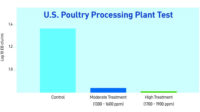VEAL AND LAMB
Exploring New Possibilities
By Megan Pellegrini, contributing writer
The veal and lamb industries are reaching out to younger consumers with more affordable, flavorful cuts.
In an effort to broaden appeal amongst consumers, the veal and lamb industries are committing to innovative production and product changes.
This summer, in a move heralded by groups such as the American Humane Society and PETA, the American Veal Association recommended the end to confinement of calves in crates over a 10-year phase-out period, while some top producers are already committing to a two- to three-year phase out. Veal consumption is currently up in Europe due to such animal-welfare reforms.
Free-range veal is gaining momentum as well, albeit at a slower pace, with American consumers and farmers, who want humanely raised veal.
The veal industry has had a difficult year so far due to oversupply and the high cost of production from rising fuel expenses and feed costs, says Tony Catelli, president and CEO of Catelli Brothers, based in Collingswood, N.J., which had great success with its Italian Bistro line last year. “To be competitive, veal and lamb have to lower production costs,” he says.
The veal industry’s go-to-market strategy creates consumer demand and encourages younger diners in particular, by leveraging foodservice messaging, retail support, public relations activity and vealstore.com to place veal on casual and chain restaurant menus, says Dean Conklin, executive director of veal marketing for the Denver-based National Cattlemen’s Beef Association.
Biaggi’s, Carino’s Italian Grill and Romano’s Macaroni Grill are now serving new cuts of veal from the previously underutilized veal square cut chuck — introduced by the industry’s Muscle Optimization Study — such as veal flat iron, petite tender, shoulder tender, filet tender and boneless shoulder rib. “We’re putting the spotlight on these new cuts, and showing the versatility and affordability of veal,” says Conklin.
Promoting lamb awareness
Lamb may not be always on consumers’ radar, but overall demand for lamb is on the rise. FreshLook Marketing Group’s 2006 year-end data reported that lamb outperformed all other proteins, as well as total meat, says Megan Wortman, marketing director of the Denver-based American Lamb Board.
Lamb dollar sales increased by 6.3 percent and pound sales increased 5.7 percent on an average price per pound increase of 0.4 percent to $4.99. In comparison, the total meat category average dollar sales fell by 0.5 percent and pound sales increased 1.1 percent on an average price per pound decrease of 1.6 percent.
Consumers generally aren’t familiar with cooking lamb, and want recipes and more consistent availability of the major cuts at retail, says Wortman. “We’ll promote loin chops, for example, on the ‘Today Show,’ and then they’re not available in stores when consumers look for them,” she says.
Foodservice remains more progressive with exploring a wide variety of uses for lamb beyond the standard rack and loin, including the lamb belly, tongues, braised shoulder, sirloin and top round.
| Annual Lamb and Mutton Forecasts | |||||
| 2004 | 2005 | 2006 | 2007 | 2008 | |
| Production (millions lbs.) | 195 | 187 | 185 | 181 | 179 |
| Per capita disappearance* (retail lb.) | 1.1 | 1.1 | 1.1 | 1.1 | 1.1 |
| Lamb and Mutton imports (millions lbs.) | 180 | 180 | 190 | 198 | 198 |
| *Per capita meat consumption data are revised, incorporating a new population series from the Commerce Department’s Bureau of Economic Analysis based on the 2000 Census. Source: World Agricultural Supply and Demand Estimates and Supporting Materials Published in Livestock, Dairy, and Poultry Outlook, www.ers.usda.gov/publications/ldp | |||||


